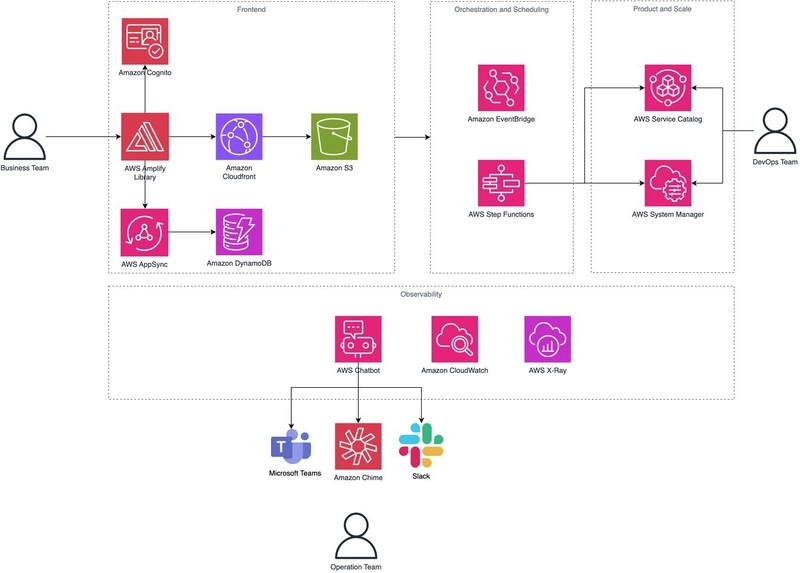Organizations across industries face operational challenges when managing planned high-traffic events. Business teams must create IT support tickets for each event, requiring DevOps teams to manually provision and scale resources. This process creates bottlenecks that impact customer experience and operational efficiency.
The “Event Scheduling on AWS” implementation sample addresses these challenges by automating resource provisioning and scaling for planned events. This sample enables organizations to deliver exceptional customer experiences during high-demand periods while reducing operational costs and eliminating manual coordination between business and technical teams.
Understanding the Challenge
Enterprises across multiple industries face similar operational obstacles when managing planned events. A media company planning a live sports broadcast must coordinate with DevOps teams weeks in advance, creating support tickets and requiring technical staff presence during events for manual scaling operations.
Retail organizations preparing flash sales encounter comparable challenges. E-commerce platforms must provision additional compute capacity, configure content delivery networks (CDNs), and scale database resources to handle sudden traffic spikes during promotional events. Manual coordination between marketing and technical teams creates delays and increases the risk of failures.
Gaming companies launching new titles or hosting e-sports tournaments face infrastructure scaling complexities. They must coordinate server provisioning across multiple regions, configure matchmaking services, and ensure backend systems can handle concurrent player loads. The manual nature of these operations often results in poor player experiences during peak gaming events.
Financial services organizations managing trading platform events encounter similar operational bottlenecks. Market events, earnings announcements, and regulatory changes require rapid infrastructure adjustments to handle increased trading volumes. Manual provisioning processes create delays that can impact trading performance and customer satisfaction.
These manual approaches increase operational overhead and extend planning timelines across industries. The risks of human error increase, IT resource utilization becomes inefficient, and organizations struggle to scale their operations effectively. These factors directly impact service quality during business-critical moments.
Solution Architecture

The “Event Scheduling on AWS” implementation sample uses an event-driven architecture built on AWS serverless technologies. AWS Step Functions orchestrates workflows through preparation, provisioning, configuration, and cleanup phases. Amazon EventBridge manages event scheduling and message coordination.
The Step Functions workflow implements a complete event lifecycle through preroll and postroll phases. The preroll phase executes before the event, managing resource provisioning, configuration validation, and system preparation tasks. During this phase, the platform deploys AWS Service Catalog products or executes Systems Manager documents for infrastructure scaling, and performs checks to ensure readiness.
The postroll phase activates after event completion, managing resource cleanup, and operational reporting. This phase terminates temporary resources, reduces infrastructure to baseline levels. The preroll and postroll approach ensures consistent event execution while optimizing resource utilization and operational costs.
AWS Service Catalog manages infrastructure deployments while AWS Systems Manager executes automation workflows. AWS AppSync provides the GraphQL API layer and Amazon CloudWatch delivers comprehensive monitoring and alerting capabilities.
The platform integrates with existing AWS services through standardized tags and IAM policies. Resources tagged with application=event-scheduling-platform become available for orchestration, enabling seamless integration with current infrastructure.
Key Organizational Benefits

Business teams gain self-service capabilities to schedule events without dependencies on IT teams. They work with familiar business metrics such as audience size and performance targets while tracking event status in real-time. This approach removes bottlenecks and accelerates event planning cycles.
Operational teams maintain visibility and control despite increased business team independence. The integration with AWS Chatbot delivers real-time notifications to Microsoft Teams and Slack channels, ensuring operational staff remain informed of all event activities. Teams receive alerts for event scheduling, resource provisioning status, execution progress, and completion notifications.
This notification system allows operational teams to monitor business-initiated events without requiring direct involvement in routine operations. They can respond quickly to issues while enabling business teams to operate independently for standard event scenarios. The integration preserves operational oversight while eliminating manual coordination bottlenecks.
DevOps teams create reusable infrastructure templates through AWS Service Catalog products and Systems Manager documents. Automation reduces manual intervention, allowing technical personnel to focus on platform improvements rather than routine operational tasks.
The implementation sample optimizes costs through automatic resource cleanup after events.
Open Architecture with AWS Service Integration
The “Event Scheduling” implementation sample provides an open framework that packages industry-specific use cases through established AWS services. This approach ensures organizations can leverage existing AWS capabilities while maintaining operational consistency and security standards.
AWS Systems Manager Integration
AWS Systems Manager documents encapsulate operational procedures for different industries. Gaming companies can create documents that scale Amazon EC2 Auto Scaling groups and configure Amazon ElastiCache clusters for tournament events. Financial services organizations can develop documents that adjust Amazon RDS replicas and modify AWS Lambda concurrency limits during trading events.
Each Systems Manager document includes built-in audit capabilities through AWS CloudTrail integration. Execution history, parameter changes, and resource modifications are automatically logged, providing complete traceability for compliance requirements. The service manages document versioning, rollback capabilities, ensuring reliable automation across distributed environments.
Kubernetes Integration for Containerized Workloads

Organizations running containerized applications can implement SSM documents that integrate with Amazon EKS clusters. These documents address the technical challenge of authenticating with EKS clusters and interacting with the Kubernetes API from SSM automation workflows.
The SSM document would enable resource pre-warming via Kubernetes Horizontal Pod Autoscaler (HPA) or Deployment for existing EKS clusters. This document would support both pre-roll actions that scale deployments before events and post-roll actions that reduce resources afterward. The integration leverages AWS Lambda functions within the SSM document to execute Kubernetes client operations, ensuring secure authentication and reliable API interactions.
AWS Service Catalog Product Packaging
AWS Service Catalog products package complete infrastructure solutions for specific event types. Service Catalog provides governance through launch constraints, template constraints, and notification constraints. Product portfolios enable different organizational units to access appropriate infrastructure templates while preventing unauthorized resource creation.
Live Video Streaming with SRT Source

Media organizations could deploy complete live video streaming infrastructure using a Service Catalog product that provisions AWS Media services. This product would address the technical challenge of provisioning live video workflows with predefined SRT input endpoints and HLS/DASH output endpoints that integrate with existing information systems.
The product would include MediaConnect for SRT source ingestion, MediaLive for video processing, MediaPackage for content packaging, and CloudFront for content delivery. Route 53 would provide predictable domain names while AWS Certificate Manager would manage TLS certificates tied to CloudFront distributions. This comprehensive approach could ensure reliable video delivery with minimal manual configuration.
Existing AWS Solutions Integration

Organizations can leverage existing AWS architectures by integrating CloudFormation or Terraform templates into Service Catalog products.
This approach allows organizations to build upon proven AWS architectures while adding custom configurations and governance controls. The integration maintains the benefits of AWS architectures while providing the automation and scheduling capabilities of the “Event Scheduling” implementation sample.
Operational Reliability
AWS Step Functions provides reliable workflow orchestration with built-in error handling, retry logic, and state management. The service automatically manages transient failures and provides detailed execution history for troubleshooting. The integration with Amazon EventBridge ensures event scheduling remains accurate even during service interruptions.
Amazon CloudWatch monitors all platform components with custom metrics, alarms, and dashboards. Organizations can track event success rates, resource provisioning times, and cost optimization metrics. AWS X-Ray provides distributed tracing capabilities for complex multi-service event workflows.
Getting Started
Follow the README.md in the GitHub project for implementation guidance.
Resource Integration
Existing AWS Service Catalog products and Systems Manager documents integrate with the platform through proper tagging. Resources must include the application=event-scheduling-platform tag to become discoverable by the orchestration system.
The platform provides automated registration scripts that discover and register properly tagged resources. This eliminates manual registration requirements and ensures consistent integration across existing infrastructure.
An audit tool validates configuration and identifies common integration issues. The tool checks IAM permissions, Service Catalog configuration, Systems Manager configuration, and resource tagging to ensure proper platform operation.
Cost Considerations
The solution uses pay-per-use AWS services including DynamoDB, Lambda, Step Functions, AppSync, and CloudWatch. Costs scale with usage patterns and event frequency rather than requiring fixed infrastructure investments.
Automatic resource cleanup after events prevents unnecessary charges from orphaned resources. The architecture design minimizes state transitions and optimizes service usage to control operational expenses.
Next Steps
The “Event Scheduling” implementation sample enables organizations to transform their event management operations by eliminating manual processes and reducing operational overhead. Organizations benefit from faster event deployment cycles, improved resource utilization, and enhanced customer experiences during business-critical moments.
Explore the open-source implementation to understand integration patterns and architectural decisions. Comprehensive documentation includes deployment guides, troubleshooting resources, and extension samples.
Start with the sample resources to understand platform capabilities, then progressively integrate existing infrastructure through proper tagging and registration processes. Audit tools help ensure successful integration and identify optimization opportunities.



